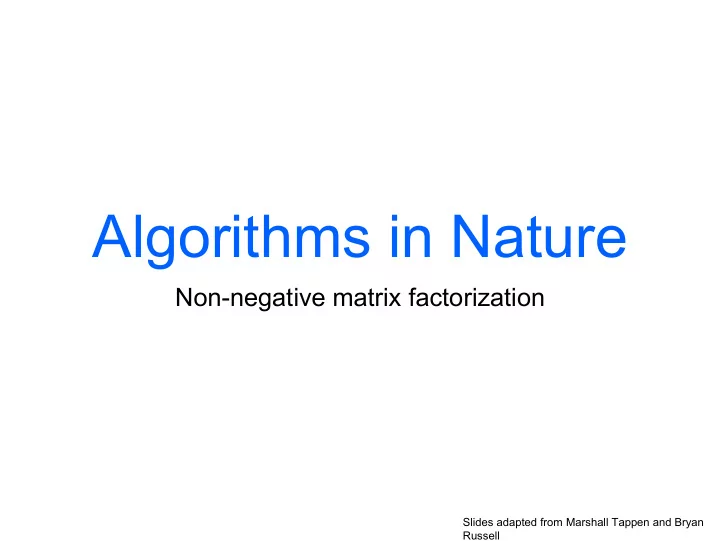

Algorithms in Nature Non-negative matrix factorization Slides adapted from Marshall Tappen and Bryan Russell
Dimensionality Reduction The curse of dimensionality: Too many features makes it difficult to visualize and interpret data Harder to efficiently learn robust statistical models Problem statement: Given a set of images.. 1. Create basis images that can be linearly combined to reconstruct the original (or new) images 2. Find weights to reproduce every input image from the basis images One set of weights for each input image
Principal Components Analysis A low-dimensionality representation that minimizes face face reconstruction error “eigenfaces”
PCA weaknesses • Only allows linear projections • Co-variance matrix is of size dxd. If d=10 4 , then |Σ| = 10 8 • Solution : singular value decomposition (SVD) • PCA restricts to orthogonal vectors in feature space that minimize reconstruction error • Solution : independent component analysis (ICA) seeks directions that are statistically independent, often measured using information theory • Assumes points are multivariate Gaussian • Solution : Kernel PCA that transforms input data to other spaces
PCA vs. Neural Networks PCA Neural Networks Unsupervised dimensionality Supervised dimensionality reduction reduction Linear representation that gives best Non-linear representation that gives squared error fit best squared error fit Possible local minima (gradient No local minima (exact) descent) Non-iterative Iterative Auto-encoding NN with linear units Orthogonal vectors (“eigenfaces”) may not yield orthogonal vectors
Is this really how humans characterize and identify faces?
What don’t we like about PCA? • Basis images aren’t physically intuitive • Humans can explain why a face is a face • PCA involves adding up some basis images and subtracting others which may not make sense in some applications: • What does it mean to subtract a face? A document?
Going from the whole to parts.. [Wachsmuth et al. 1994] Recording from neurons in the temporal lobe in the macaque monkey
Going from the whole to parts.. [Wachsmuth et al. 1994] Neurons that respond primarily to the body spontaneous background activity control
Going from the whole to parts.. [Wachsmuth et al. 1994] Overall, recorded from 53 neurons: 17 (32%) responded to the head only 5 (9%) responded to the body only 22 (41%) responded to both the head and the body in isolation 9 (17%) responded to the whole body only ( neither part in isolation) Suggestive of a parts-based (Today) representation with possible hierarchy
Non-negative matrix factorization Trained on 2,429 faces Like PCA, except the coefficients in the linear combination must be non-negative Forcing positive coefficients implies an additive combination of sparser encoding (vanishing coefficients) basis parts to reconstruct whole Several versions of mouths, noses, etc. Better physical analogue in neurons
Formal definition of NMF n ⨉ r matrix; r r ⨉ m matrix; r n ⨉ m matrix of columns are coefficients to image the basis represent each database. n= # images, each of the m faces non-negativity constraints pixels/face; of size n; m= # faces “ eigenfaces ” WH is a compressed version of V How to choose the rank r? Want (n+m)r < nm
A similar neural network view n ⨉ r matrix; r r ⨉ m matrix; r n ⨉ m matrix; input columns are the coefficients to image database. basis images, each represent each of n=# of pixels/face; of size n the m faces m = # of faces non-negativity constraints hidden variables; parts-based representation original image pixels
One possible objective function Reconstruction error: Update rule: a th basis projection for i th pixel Normalize ratio of actual to update a th reconstructed pixel coefficient for the value for the u th u th face sum over all pixels face
One possible objective function Update rule: a th basis projection for i th pixel Normalize ratio of actual to update a th reconstructed pixel coefficient for the value for the u th u th face sum over all pixels face Basic idea: multiply current value by a factor depending on the quality of the approximation. If ratio > 1, then we need to increase denominator. If ratio < 1, then we need to decrease denominator. If ratio = 1, do nothing.
What is significant about this? • The update rule is multiplicative instead of additive • In the initial values for W and H are non-negative, then W and H can never become negative • This guarantees a non-negative factorization • Will it converge? • Yes, to a local optima: see [Lee and Seung, NIPS 2000] for proof
PCA vs. NMF PCA NMF Unsupervised dimensionality Unsupervised dimensionality reduction reduction Orthogonal vectors with positive and Non-negative coefficients negative coefficients “Parts - based”; easier to interpret “Holistic”; difficult to interpret Non-iterative Iterative (the presented algorithm) CS developed Biologically- “inspired” (alas, there are inhibitory neurons in the brain)
The ‘Jennifer Aniston’ neuron [Quiroga et al., Nature 2005] • UCLA neurosurgeon Itzhak Fried and researcher Quian Quiroga operating on patients with epileptic seizures • Procedure requires implanting a probe in the brain, but doctor first needs to map surgical area (fyi, open brains do not hurt) • “Mind if I try some exploratory science?” • Flashed one-second snapshots of celebrities, animals, objects, and landmark buildings. Each person shown ~2,000 pictures. • When Aniston was shown, one neuron in the medial temporal lobe always flashed • Invariant to: different poses, hair styles, smiling, not smiling, etc. • Never flashed for: Julia Roberts, Kobe Bryant, other celebrities, places, animals, etc.
Hierarchical models of object recognition Stirred a controversy: Are there ‘grandmother cells’ in the brain? [Lettvin, 1969] Or are there populations of cells that respond to a stimuli? Are the cells organized into a hierarchy? (Riesenhuber and Poggio model; see website)
Recommend
More recommend